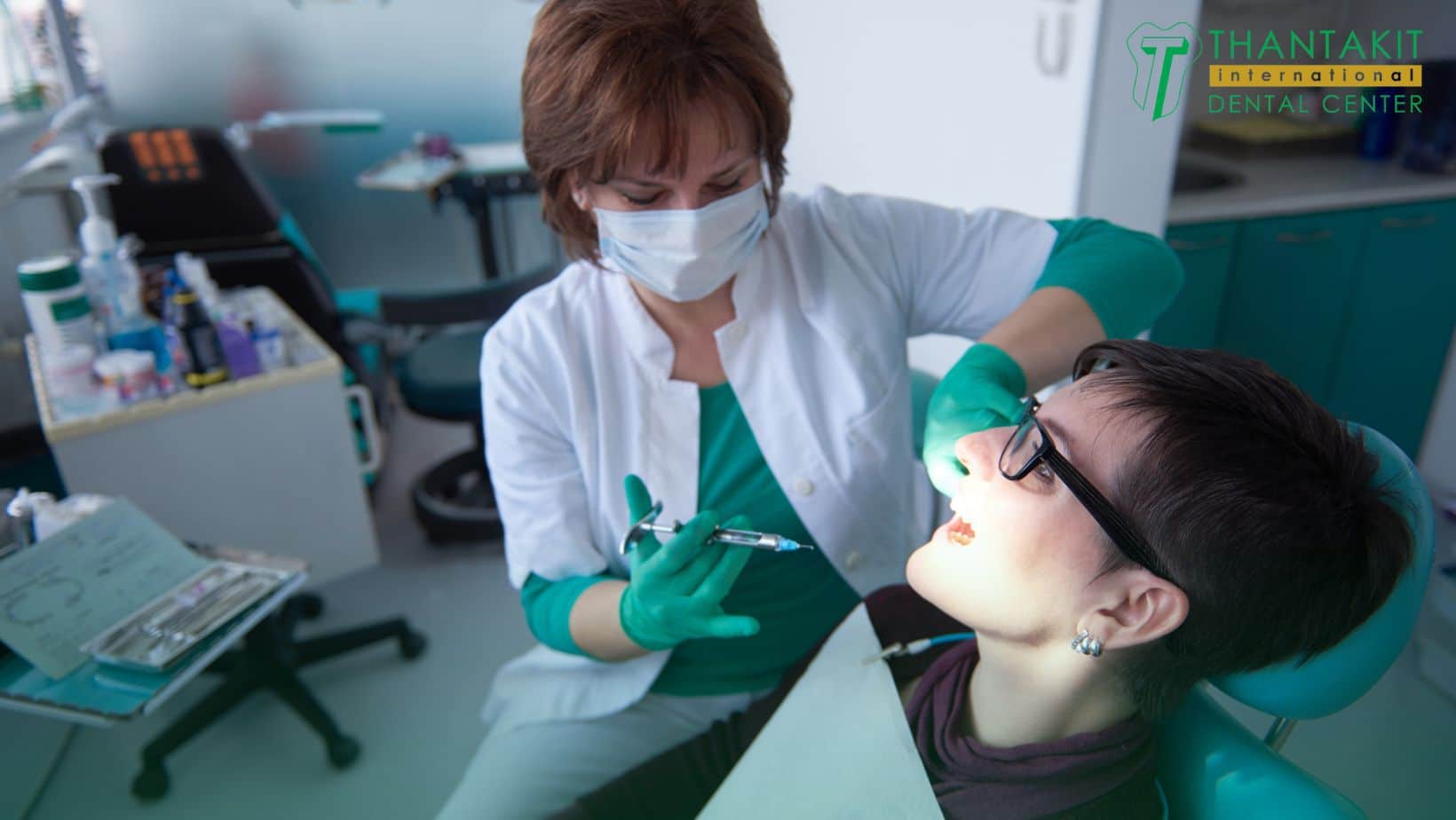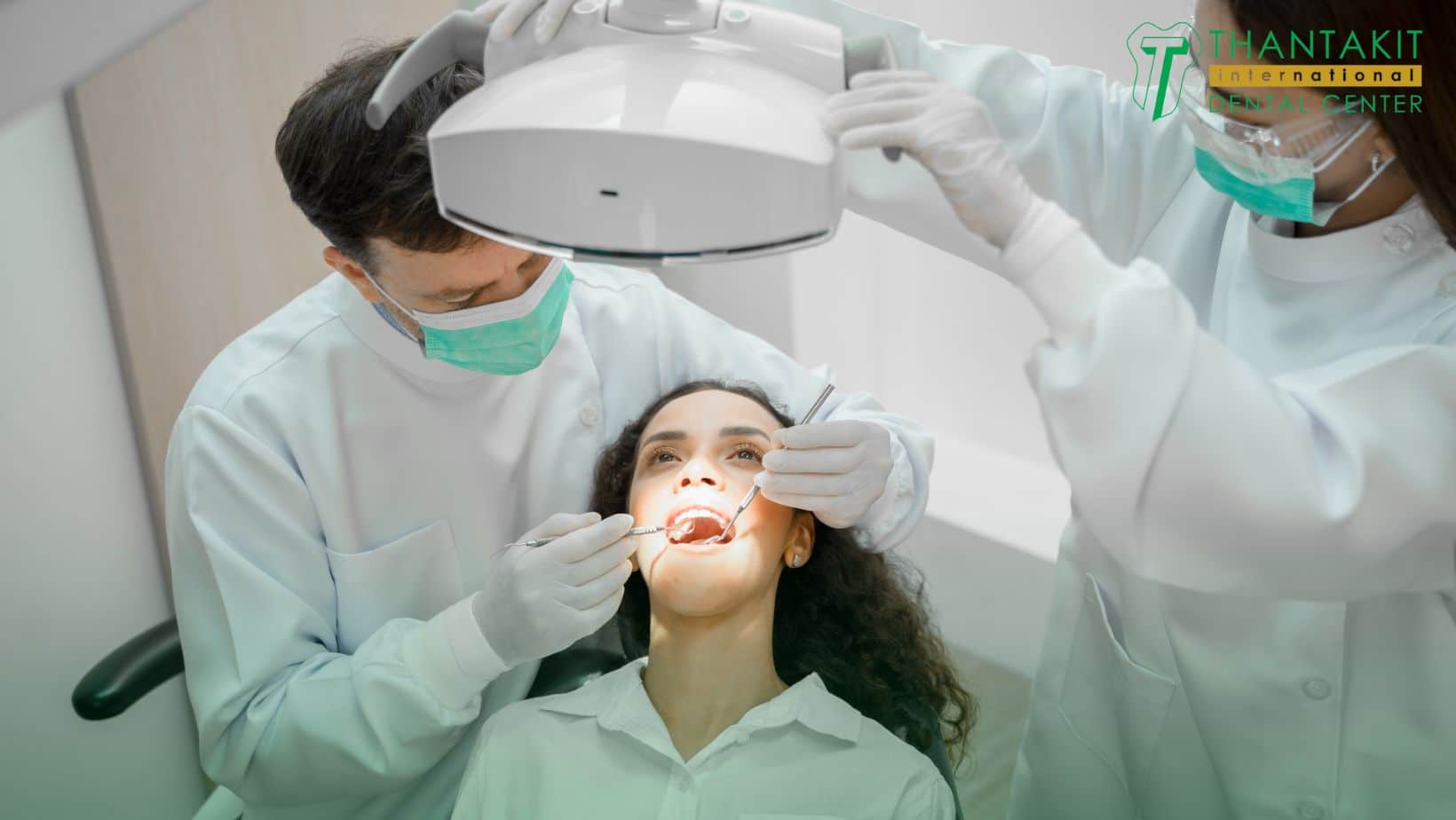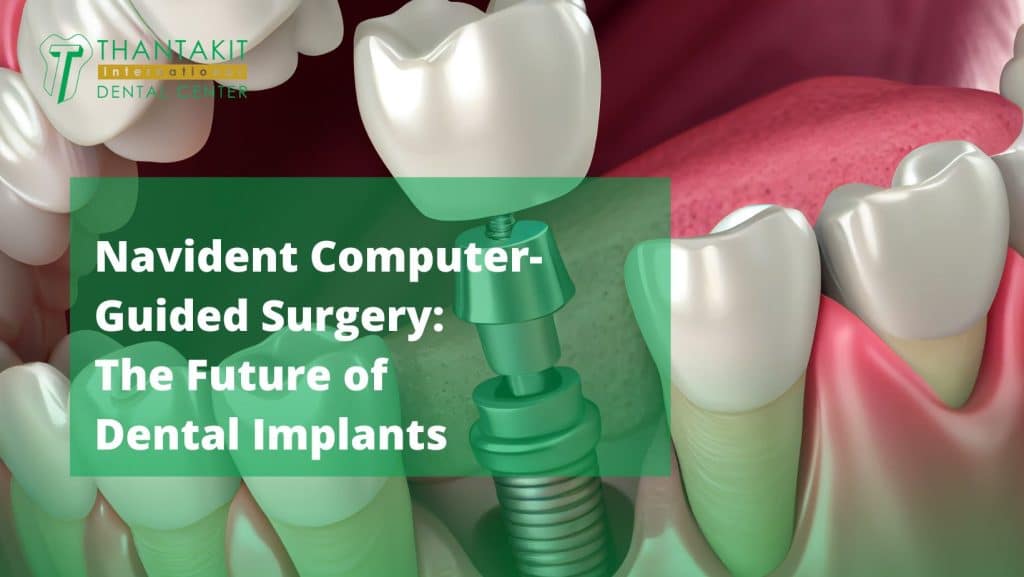What best fills a missing smile? In recent years, many people have considered dental implants to be the ideal remedy, boasting an early implant survival rate of over 90%.
With more and more people seeking long-term solutions to regain their confident smile, dental technologies are also continuously searching for ways to better their procedures.
One leading innovation is computer-guided implant surgery—specifically the Navident system. This cutting-edge technology uses real-time CBCT data for 3D navigation, resulting in precise, safe, and comfortable implant placement experiences. And this is just a glimpse of Navident’s full scope.
Read on to unravel the wonders of computer-guided surgery and how it has become a game-changing procedure at Thantakit International Dental Center.
Page Contents
Breaking Down Computer-Guided Implant Surgery
Think of getting dental implants so precise that it feels like your dentist designed the perfect blueprint for your smile. Such is the promise of computer-guided implant surgery.
This game-changing technology combines advanced imaging with 3D navigation to achieve unparalleled accuracy. Dentists can then visualize their patient’s oral structures in three dimensions. That gives you peace of mind, knowing your dental implants are meticulously placed with millimeter-level accuracy.
But this method isn’t only about achieving top precision. These days, computer-guided surgeries have redefined dentistry. Medical gadgets that use this technology can minimize the risks of surgical complications while reducing recovery times. All these outcomes are what most patients seek when considering dental implants in Thailand.
At the core of this innovation are CT scans and CAD/CAM technology. CT scans reveal three-dimensional images of your jawbone. That provides vital anatomical details for dentists, such as nerves, blood vessels, and bone density.
This information is then fed to a CAD/CAM software, which can adapt a virtual treatment plan. Incorporating imaging precision with digital design enables dentists to pre-plan every phase of the implant procedure, resulting in a seamless process.
Navident is one of the most promising systems, offering up to 0.5mm accuracy. Unlike static guides (usually fixed into position), Navident offers flexibility to the point where dentists can adjust the treatment plan even during an operation without compromising accuracy.
Choosing to undergo implant surgery with this technology means you want the best possible outcomes without fear, discomfort, or long recovery times.

Navident vs. Traditional Surgery: Explaining Differences
Innovations continue to redefine patient care and dentistry outcomes. To appreciate how revolutionary the Navident system is in dental implantology, it will be worth comparing this approach with traditional methods. Designed to elevate all aspects of the implant process, Navident provides a more efficient surgical experience through the following features:
Precision and Accuracy
Traditional approaches rely on two-dimensional X-rays and manual techniques. While effective, they leave room for inaccuracies stemming from restricted visualization and static measurements. This can result in your implants being slightly misaligned or positioned suboptimally.
On the other hand, Navident uses real-time 3D navigation. That gives you the assurance that your implants will be secured with millimeter-level exactness for more reliable outcomes.
Reduced Invasiveness
In most cases, traditional implant surgeries require larger incisions and extensive tissue manipulation. Hence, patients often experience postoperative discomfort and pain while also enduring longer recovery.
Navident-driven procedures spare you from these unpleasant experiences as 3D navigation lessens surgical invasiveness. With better-targeted implant sites, incisions have become smaller, minimizing damage to surrounding tissues.
Safety and Predictability
The success of traditional implant methods is grounded on the dentist’s skills and pre-surgical static guides. This approach often cannot foresee challenges that arise during surgery.
Navident eliminates these obstacles by providing continuous feedback throughout the procedure. Dentists can then adjust their approach on the spot to promote safety while giving results with higher predictability.

Key Benefits of Computer-Guided Surgery You Must Know About
Beyond addressing the limitations of conventional implant methods, computer-guided surgery leverages state-of-the-art technology to offer surprising benefits. Here’s a rundown on some of the most favorable advantages of choosing Navident-driven implant surgery, aside from this method’s unmatched accuracy:
Real-Time Navigation
Navident provides dynamic, 3D visualizations during an implant procedure. That empowers dentists to make precise adjustments for optimal implant placements without harming surrounding oral structures.
Improved Aesthetics
Millimeter-level precision opens doors for exact implant positioning. That reflects a more natural look and feel that will complement your unique facial structure and smile.
Time Efficiency
Along with accuracy comes a streamlined surgical process that offers you the opportunity to achieve your dental goals even when time and convenience aren’t at your side. Also, there will be fewer post-surgical follow-ups.
Optimized for Complex Cases
Patients facing irregular jaw anatomy or lower bone density will find computer-guided implant surgery ideal for their situation. Navident can help eliminate the need for additional surgeries (such as bone grafting) that may otherwise be required in traditional implant procedures.
Customized Treatment Plans
The Navident system is known for its advanced imaging and 3D mapping features. Such technology makes every procedure tailored to the patient’s anatomy and unique dental needs for maximized success.
Increased Comfort
With computer-guided surgery’s less invasive nature, you can expect a more pleasing overall experience. Dentists who use this technology promise smaller incisions and reduced tissue disruption.
Long-Term Success
Navident reduces errors and enhances implant stability for a more lasting solution you can rely on. With proper care, you can enjoy long-term functionality while maintaining your implant’s aesthetic appeal.

Precision in Phases: A Closer Look into the Computer-Guided Surgery Process
After exploring the potential benefits, you can enjoy from undergoing computer-guided surgery, it’s equally valuable to understand how this technology is translated into practice. Learning the step-by-step process can offer you clarity and confidence before making an appointment.
If you are considering multiple options for your dental needs, knowing how Navident integrates advanced innovations becomes increasingly crucial. Apart from alleviating anxiety, familiarizing yourself with the steps involved in Navident surgery empowers you to make informed decisions for your oral health. Keep in mind the following key phases for this procedure:
Consultation and Assessment
Implant surgeries begin with a thorough evaluation and diagnosis. Leveraging 3D imaging technology, your dentist will assess your oral anatomy to determine where your dental implants can be positioned best.
This phase is crucial as your dentist will have to think about essential structures like nerves and sinuses. Once enough data has been gathered, this information will form the basis of your personalized treatment plan.
Digital Workflow
In the next phase, your dentist will utilize a CAD/CAM system to develop a virtual surgical guide. This comprehensive guide focuses on mapping out the exact positioning, angle, and depth of the implant for excellent precision.
It is here that your dentist may collaborate with other medical professionals if necessary. The goal of this phase is to lay out the procedure to ensure a smooth sailing experience.
Implant Placement
It is in this phase that the dentist performs the implant surgery through the guidance of the custom-made guide developed in the prior phase. The Navident system’s real-time navigation provides millimeter-level accuracy to mitigate the risks of complications while improving efficiency.
Compared to conventional implant surgery, this option offers faster durations that many appreciate for comfort and convenience.
Post-Surgery Care and Monitoring
After a successful surgery, your next objective must be to recover and attend follow-ups. Your dentist will give you detailed instructions for aftercare. Always follow their advice to promote faster healing and reduce post-op discomfort.
It’s also advisable to have regular checkups so your dentist can monitor how well your implants are integrated into the jawbone. This phase emphasizes the value of patient-centered care and ongoing support to attain optimal and long-term results.

Reasons to Choose Thantakit as Your Implant Surgery Provider
After knowing the step-by-step process of computer-guided surgery, you may now be more confident in choosing your providers. By syncing Navident technology with unparalleled expertise and a dedication to personalized care, Thantakit International Dental Center stands out as a top choice for Bangkok locals and medical tourists alike. Here are more reasons that make Thantakit the trusted choice for dental implant solutions in Thailand:
Experience and Expertise
With a decades-spanning legacy, Thantakit Dental Center has been Thailand’s pioneer in dental care since 1945. We’re even the practice that introduced the country to dental implant surgery in 1973. As a third-generation, family-run business, we treat each of our patients as if they were members of our extended family by upholding trust and compassion.
Beyond our history and values, the Thantakit dental team comprises Thailand’s most promising names in dentistry, rigorously trained and experienced to provide world-class treatments. From routine dental care to elaborate surgeries, our professionals will always strive to give you the highest standard of care when you entrust your dental needs to us.
Personalized Patient Care
Upholding our promise to treat patients as family, Thantakit doesn’t follow a uniform approach to handling cases. Each of our patients can expect a carefully tailored treatment plan with their needs, goals, and medical history as the main foundation.
Our dental team will ensure clear communication and comprehensive guidance at every phase of your engagement with our practice. Promoting individualized care is our way of strengthening your trust in our professionals, making you feel valued and supported throughout your dental journey with us.
Global Reputation
Aside from earning the trust of many locals in Thailand, Thantakit International Dental Center also attracts patients from across the globe—especially in Australia. This international recognition serves as a clear testament to Thantakit’s commitment to excellence.
This equips our practice with understanding the unique needs of dental tourists. We even offer transportation services for our patients between their hotel and our clinic during all their appointments FREE of charge. This offers those who are unfamiliar with the area a stress-free experience.
State-of-the-Art Facilities
Our Bangkok dental practice is equipped with cutting-edge medical technology. Apart from maximizing top-standard innovations, Thantakit Dental Center ensures all treatments are performed by highly capable professionals to maintain world-class safety, care, and hygiene standards.
With an emphasis on patient comfort from consultations to post-operative follow-ups, you can expect nothing less than a facility that exudes progress and modern dentistry.
For those reasons, we’ve earned the trust of countless individuals worldwide. But don’t just take our word. Instead, let our patient’s experiences speak volumes about what we can offer you. Consider taking the time to listen to one of our Australian patients as he shares his insights about getting his implants at Thantakit International Dental Center:
How Much Do Navident Implants Cost at Thantakit?
Choosing the best provider for your implant surgery doesn’t stop at evaluating the quality of care each dentist can offer. It also involves assessing the value they can give to your investments.
Thantakit International Dental Center blends state-of-the-art technologies (like Navident) with personalized care and exceptional expertise. But the question here is: how much budget should you allocate to avail yourself of this world-class service? To give you a clear picture, explore this table detailing the cost of computer-guided implant surgery:
| Implant Type | Cost (THB) | USD | GBP | AUD | NZD |
|---|---|---|---|---|---|
| Single Implant with Zirconia Crown | THB 8,000 | USD 239 | GBP 180 | AUD 374 | NZD 400 |
| 2 Implants with 3-Unit Bridge | THB 7,000 per implant | USD 209 | GBP 157 | AUD 327 | NZD 350 |
| 2 Implants with 4-Unit Bridge | THB 7,000 per implant | USD 209 | GBP 157 | AUD 327 | NZD 350 |
Keep in mind that the final pricing may have a slight difference because of factors like the complexity of your anatomy or the materials used for your implants.
While this method may have a higher initial cost compared to traditional ones, Navident technology offers outstanding precision that leads to longer-lasting results. This eliminates the need to spend additional money to undergo corrective surgeries in the future.
Navident’s digital accuracy also reduces errors during surgery, meaning fewer complications and follow-up visits. Choosing this cutting-edge approach can help you save on additional expenses, making it the ideal choice if you want a cost-effective solution over the long term.

Answering FAQs Related to Thantakit’s Navident Implant Surgery
With information about advanced dental procedures becoming more accessible, questions about computer-guided implant surgery naturally arise. Presented in this section are the most common inquiries about Navident technology and the best answers offered by our dental professionals.
FAQ 1: Is It Safe?
Many experts regard computer-guided surgery as one of the safest options for dental implant placement. The procedure uses advanced features (like 3D imaging and real-time navigation) to lessen the risk of complications and preserve surrounding structures.
Dentists gain unparalleled control during surgery since Navident provides 0.5mm-level precision that leaves virtually no room for errors compared to traditional methods that rely on static guides. For such reasons, using this technology paves the way for predictable surgical experiences that will give dentists and patients peace of mind.
FAQ 2: Who Is Eligible for Computer-Guided Surgery?
This advanced service is available for anyone needing dental implants—especially those with unique oral health situations. Individuals who will benefit most from Navident include those dealing with bone loss, complex oral anatomy, or multiple missing teeth.
Understanding one’s eligibility entails assessing several factors like oral health, bone density, and overall medical history. However, this is something you shouldn’t be stressed about, as this will be your dentist’s responsibility. At Thantakit, we utilize 3D imaging for an accurate assessment of your suitability for this type of surgery and will offer you alternative procedures if otherwise.
FAQ 3: How Long Does the Procedure Take?
Surgery duration at Thantakit varies on a case-to-case basis since factors like the number of implants and the complexities of your situation will affect how long you’ll stay in the dental chair. However, thanks to digital pre-planning and real-time adjustments, positioning the implant is faster than traditional methods.
FAQ 4: What Is the Recovery Time?
Since the surgery is less invasive than the traditional method, recovery time is generally shorter. With this procedure, patients experience less swelling and discomfort.
However, osseointegration—or the full integration of the implant with the jawbone—may take a few months to happen. Hence, adhering to your dentist’s aftercare instructions and going to follow-ups play a crucial role in a successful recovery.
FAQ 5: How Much Does It Cost?
Since this type of surgery uses the latest innovations, it requires a higher upfront cost than you may be used to. Several factors affect the pricing such as the number of implants, the materials used, and the complexity of the case—so these are something to consider.
Rest assured, Thantakit doesn’t impose any hidden charges. If you wish to explore your payment or financing options more, we encourage you to contact us at your convenience.
The Key Takeaways About Computer-Guided Dental Surgeries in Thailand
If dental implants are your top consideration, it’s best to invest in a treatment that promises longevity. Computer-guided implant surgery goes beyond long-term functionality as it’s also one of the most precise and less invasive methods available to you.
Then again, this type of procedure can get too costly in most countries since it involves using cutting-edge technology.
For a wallet-friendly alternative, consider Thai dental tourism. Thantakit Dental Center in Thailand promises world-class computer-guided implant surgeries minus the off-the-roof prices.
Backed up by our experience as pioneers in Thai dentistry, choosing Thantakit International Dental Center means you’re giving yourself the best dental care without compromising your savings. Our practice has become so established that many patients fly to Bangkok from far-off places like Australia and the USA just so they can entrust their dental needs to the most capable hands.
Contact us today and enjoy your FREE dental consultation!












